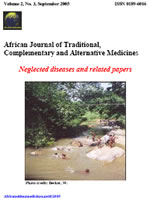
|
African Journal of Traditional, Complementary and Alternative Medicines
African Ethnomedicines Network
ISSN: 0189-6016
Vol. 14, No. 5, 2017, pp. 72-79
|
 Bioline Code: tc17060
Bioline Code: tc17060
Full paper language: English
Document type: Research Article
Document available free of charge
|
|
|
African Journal of Traditional, Complementary and Alternative Medicines, Vol. 14, No. 5, 2017, pp. 72-79
| en |
DIVERSITY OF MEDICINAL PLANTS AND ANTHROPOGENIC THREATS IN THE SAMBURU CENTRAL SUB-COUNTY OF KENYA
Gafna, Dikko J.; Dolos, Klara; Mahiri, Ishmael O; Mahiri, Joseph G. & Obando, Joy A.
Abstract
Background: Traditional herbal medicine has been a constant source of substances for curing and preventing a variety of
ailments. Biodiversity of medicinal plants and effects of human activities on availability of traditional herbal medicine have
continuously received just a cursory treatment. This study sought to determine the biodiversity of medicinal plants and
evaluate the effects of human activities on availability of traditional herbal medicine among the Samburu pastoral
community in Kenya.
Materials and
Methods: A questionnaire survey was addressed to 195 randomly stratified household respondents in four
villages in Samburu Central Sub-county. Transect walks were carried out in the four villages to determine the diversity of
the medicinal plants. Voucher specimens of the medicinal plant species were deposited at Kenyatta University Herbarium.
Results: The species richness comprised of 19 medicinal plants, majority of which grew in the wild but were threatened by
human activities. 56% of the households reported that fire incidences highly affected availability of traditional herbal
medicine, 50% reported that grazing of livestock moderately affected availability of traditional herbal medicine, 46%
reported that building and construction activities moderately affected availability, while 43% and 40% reported that
firewood collection and growing of crops respectively lowly affected availability of traditional herbal medicine among the
Samburu people.
Conclusion: Most of the Samburu people use traditional herbal medicine. However, majority of the medicinal plants are
threatened by anthropogenic factors. This has led to the continued decline of traditional herbal medicine. There is, therefore
need to adopt management strategies that enhance the conservation of these valuable natural resources.
Keywords
medicinal plant; traditional herbal medicine; Kenya; Samburu
|
| |
© Copyright 2017 - African Journal of Traditional, Complementary and Alternative Medicines
Alternative site location: http://journals.sfu.ca/africanem/index.php/ajtcam
|
|
